
Samek 1/700 HMS Vanguard
| KIT #: | ? |
| PRICE: | $ |
| DECALS: | None |
| REVIEWER: | Frank Spahr |
| NOTES: | Resin |

| HISTORY |
HMS Vanguard was the last British battleship and thus inappropriately named, yet those responsible for naming her in 1941 could not have been aware of this fate. Originally the British had meant to build a new class of battleships in the late 1930ies to strengthen their Far East Fleet. The four units of the Lion class would have been formidable and well-designed ships with a main armament of nine 16 inch guns. The outbreak of World War 2 necessitated using available building capacities for the most urgent projects only, mainly escorts – hence work on the Lion class had to be halted. Soon the entire project was abandoned.
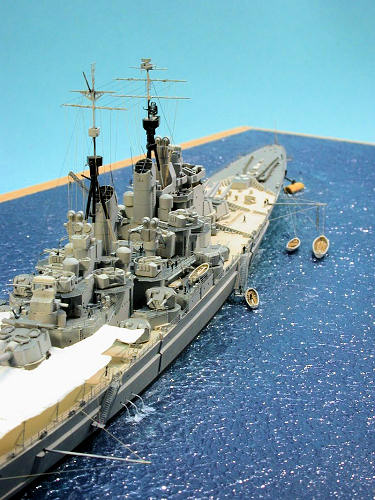 Already in 1939 a
proposal was submitted for building at least one battleship based on the Lion
design, but using gun mountings left from World War 1. It took until the spring
of 1941 until a building order for HMS Vanguard could be placed with John
Brown, Clydeside. Despite the high priority now assigned to the project, the
shipyard lacked skilled workers, so progress was slow. The ship was launched in
1944 and commissioned only in 1946 – too late for the war effort and too late to
be really of use. In fact, the Royal Navy´s grave post-war financial situation
soon made her more a liability than an asset for the Admiralty.
Already in 1939 a
proposal was submitted for building at least one battleship based on the Lion
design, but using gun mountings left from World War 1. It took until the spring
of 1941 until a building order for HMS Vanguard could be placed with John
Brown, Clydeside. Despite the high priority now assigned to the project, the
shipyard lacked skilled workers, so progress was slow. The ship was launched in
1944 and commissioned only in 1946 – too late for the war effort and too late to
be really of use. In fact, the Royal Navy´s grave post-war financial situation
soon made her more a liability than an asset for the Admiralty.
During her very short active service, Vanguard never fired a shot in anger. In 1947 King George VI sailed aboard her on his voyage to South Africa; afterwards she served mainly as Flagship of the Home Fleet, stationed in Portsmouth. At the end of 1954 she was placed in reserve, where she remained for five years. In October, 1959 it was decided to scrap her, after all efforts of preserving her as a museum ship failed. Until the present day, this has happened to many other grand old vessels – most recently to HMS Fearless.
In August, 1960 she left Portsmouth under tow bound for Faslane for scrapping; right at the beginning of her last voyage, she broke loose and nearly struck Southsea pier, yet could be brought under control at the last moment and be brought to her final destination without further mishaps. This incident is reminiscent of HMS Warspite a decade before. She also broke loose during her last trip off the Cornish coast and beached in Prussia Cove, where she had to be broken up in situ. Those that visit Marazion and St. Michael´s Mount may notice a memorial to this grand old ship.
Vanguard was the largest British battleship ever, and probably the best-designed one, too. Her long building period enabled to incorporate lessons learned during wartime. She proved to be a better seaboat than the preceding King George V – class, the bows of which had been kept deliberately low to present a free arc for shooting even at zero elevation. The price to pay was a very wet fo`c´sle. Vanguard´s markedly different bow with a more pronounced flare and sheer proved its worth well. Another very notable difference was the transom stern she had received to limit overall length and facilitate docking in as many bases as possible. Her sophisticated fire control systems and radar equipment made use of all the advances made during the war. Other novelties such as an ops room were incorporated into the design, yet not in full due to lack of space.
Vanguard´s main armament, a subject of many discussions, comprised of four twin 15 inch mountings originally slated for the two large light cruisers Courageous and Glorious of WW1 notoriety, known as „Fisher´s Follies“. The actual guns came from a pool of guns that had been used on various vessels of the R – class and Queen Elizabeth class. Those mountings and turrets were thoroughly revised and added to the new vessel.
Vanguard may be remembered as a well-designed and attractive vessel that came too late and hence spent her short service as a „white elephant“.
 Technical Data
(Wikipedia):
Technical Data
(Wikipedia):
|
Ordered |
14 March 1941 |
|
Laid down |
2 October 1941 |
|
Launched |
30 November 1944 |
|
Commissioned |
9 August 1946 |
|
Decommissioned |
9 October 1959 |
|
Fate |
Scrapped at Faslane from 9 August 1960 |
|
Displacement |
48,500 tons |
|
Length |
814 ft 6 ´´ (246.8 m) |
|
Beam |
107 ft 7 in (32.8 m) |
|
Draught |
30 ft 6 in (9.3 m) |
|
Propulsion |
8 Admiralty-type boilers / 4 Parsons geared turbines / 130,000 shp |
|
Speed |
30 kn (55,5 km/h) |
|
Range |
9,000 nm @ 20 kn |
|
Complement |
1,500 |
|
Sensors |
· 1 x Radar Type 960 air warning · 1 x Radar Type 293 target indication · 1 x Radar Type 277 height finding · 2 x Radar Type 274 15-inch fire control · 4 x Radar Type 275 5.25-inch fire control · 10 x Radar Type 262 40 mm fire control |
|
Armament |
· 8 x 15in/42 (381 mm) in 4 twin mountings Mark IN · 16 x 5.25 in /50 (133 mm) guns in 8 twin mountings · 54 x 40mm/60 Bofors AA guns in 9 sextuple mountings · 2 × 40 mm /60 Bofors AA guns in twin mounting · 11 × 40 mm /60 Bofors AA guns in single mountings · 4 x QF 3 pdr (47 mm) saluting |
|
Motto |
We lead |
| THE KIT |
Michal Samek from the Czech Republic has produced an excellent 1:700 resin kit of HMS Vanguard that also contains the specific PE parts needed, albeit no railings. The stainless steel PE is made by Eduard . I added machined brass barrels from NNT plus PE railings and crew figures by Lion Roar. The kit has been previewed in the English language by Pavel Vacata on www.modelwarships.com , and in German by Patrick Vogel and Ralf Schuster on www.modellversium.de – both reviews end up very favorably for the kit.
| CONSTRUCTION |
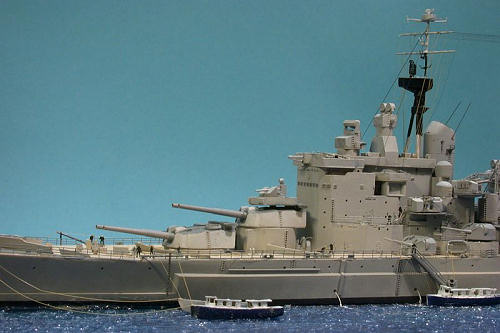 The rather small
number of parts and the very sharp casting speeded up construction a lot. Little
cleanup was necessary, and the instructions, even though hand drawn in a rather
simple manner, proved to be mostly useful. The only point I found worthy of
improvement concerned construction of the masts – I would have appreciated
measurements and clearer drawings. The kit PE proved to be useful, especially
the safety netting surrounding the Bofors mounts on the superstructure. Yet the
material used is very soft and challenging to work with – proceed with caution.
The Lion Roar railings are very sharp and finely detailed, yet harder to remove
from the fret than my personal favorite parts from WEM – there is very little
space for my scissors or knife around the actual parts.
The rather small
number of parts and the very sharp casting speeded up construction a lot. Little
cleanup was necessary, and the instructions, even though hand drawn in a rather
simple manner, proved to be mostly useful. The only point I found worthy of
improvement concerned construction of the masts – I would have appreciated
measurements and clearer drawings. The kit PE proved to be useful, especially
the safety netting surrounding the Bofors mounts on the superstructure. Yet the
material used is very soft and challenging to work with – proceed with caution.
The Lion Roar railings are very sharp and finely detailed, yet harder to remove
from the fret than my personal favorite parts from WEM – there is very little
space for my scissors or knife around the actual parts.
Construction started
by identifying subassemblies that could be built and painted simultaneously –
the hull, fore and aft superstructure, funnels, turrets, AA mounts, boats,
cranes, radars and directors. I left most of them on the thin resin wafers to
ease painting.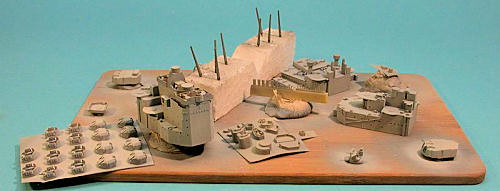
The hull was
cleaned up easily, nonetheless I produced some unsightly blemishes on the
quarterdeck while trying to fill some air bubbles. As I had already decided to
mount a really large awning over
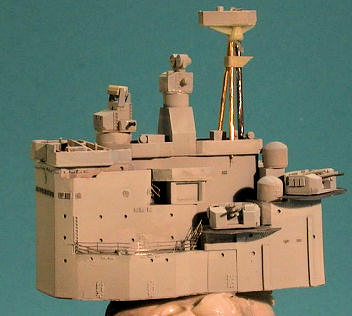 the quarterdeck, I didn´t mind
that much. Mounting holes were drilled through the hull in barbettes A and X
using an electric drill in a stand.
the quarterdeck, I didn´t mind
that much. Mounting holes were drilled through the hull in barbettes A and X
using an electric drill in a stand.
After making sure the two superstructure blocks fit well on the hull, I started gluing the more delicate parts to them. Those boat cradles that later on would not receive boats were replaced by PE items from various WEM sets, mostly from the invaluable Askold set. All the scuttles, hawsers plus those water outlets I could identify on my reference images were drilled open carefully. Constructing the masts was fiddly as it always is, and further complicated by the lack of information in the instructions. Various steel and brass wires were used. The Raven/Roberts drawings were consulted re measurements and placement of the various PE parts. The material used by Eduard proved harder to work with than what I had used previously. Moreover, many parts like inclined ladders looked inferior to generic parts of other manufacturers; where applicable, these were substituted with WEM parts.
| COLORS & MARKINGS |
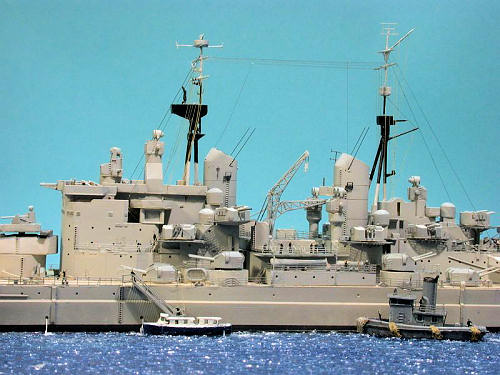 The hull was primed
with enamel primer and then sprayed AP 507 C Light Admiralty Grey (as all
weatherworks) using WEM Colourcoats. The boot topping was masked and sprayed a
generic dark grey. The wooden decks were hand painted JPS Acrylic IJN Deck Tan
and given a watercolour wash. All the remaining steel decks were painted JPS
Acrylic IJN Maizuru Grey, the decks covered with Corticene were painted WEM
Corticene. As always, the acrylics worked well – I hadn´t learned about the
ideal thinners for WEM Colourcoats yet, so found working with them less easy. In
the meantime, I learned from modeling friends (and tried it myself) that
Colourcoats work best with Xtracolor thinners. Cheap CA glue was the only
adhesive used.
The hull was primed
with enamel primer and then sprayed AP 507 C Light Admiralty Grey (as all
weatherworks) using WEM Colourcoats. The boot topping was masked and sprayed a
generic dark grey. The wooden decks were hand painted JPS Acrylic IJN Deck Tan
and given a watercolour wash. All the remaining steel decks were painted JPS
Acrylic IJN Maizuru Grey, the decks covered with Corticene were painted WEM
Corticene. As always, the acrylics worked well – I hadn´t learned about the
ideal thinners for WEM Colourcoats yet, so found working with them less easy. In
the meantime, I learned from modeling friends (and tried it myself) that
Colourcoats work best with Xtracolor thinners. Cheap CA glue was the only
adhesive used.
| FINAL BITS |
Making the very
large awning took some thought and work; after leafing through my store of PE
parts I decided to use some of my stock of Scheuer&Struever´s 1:250 PE railings
for
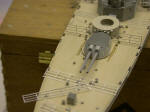 the transversal fra
the transversal fra mes. They were reasonably stiff and
could be adapted to the various beams needed. Longitudinal fasteners were made
from stretched sprue. The material of choice for making awnings is white glue,
yet it only works up to a certain size of the individual segments. In this case
with fairy large segments, I decided to try something new; so I bought Cigarette
Papers Of Considerable Size. These were carefully prepainted with JPS
Acrylic IJN Deck Tan and glued to the framing in various segments using white
glue. After trimming the excess and touching up the paint, I sealed the awning
with Future.
mes. They were reasonably stiff and
could be adapted to the various beams needed. Longitudinal fasteners were made
from stretched sprue. The material of choice for making awnings is white glue,
yet it only works up to a certain size of the individual segments. In this case
with fairy large segments, I decided to try something new; so I bought Cigarette
Papers Of Considerable Size. These were carefully prepainted with JPS
Acrylic IJN Deck Tan and glued to the framing in various segments using white
glue. After trimming the excess and touching up the paint, I sealed the awning
with Future.
A fter
adding all the subassemblies and crew figur
fter
adding all the subassemblies and crew figur es,
the railings were added. Sounding platforms were made by bending the railing and
adding a „floor“ from white glue.
es,
the railings were added. Sounding platforms were made by bending the railing and
adding a „floor“ from white glue.
The model was rigged using black and tan stretched sprue respectively for standing rigging and signal lines. The rigging was glued using liquid plastic cement, a heated dental waxing instrument was used for tightening the lines. Finally, the model was given a flat coat to blend things in and hide glue spots.
| THE BASE |
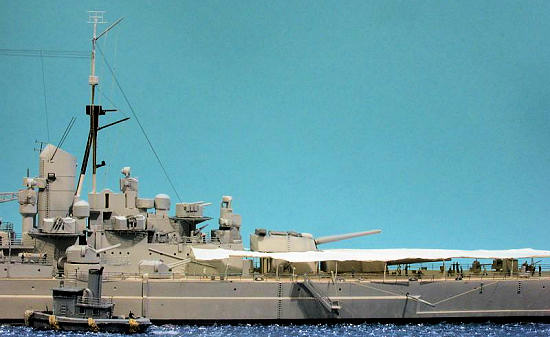 I had decided right
at the beginning to present the vessel in calm waters on a sunny day; one would
have to modify the waterline hull to present the vessel in heavy seas. As
Vanguard served as flagship for most of her short service, I assumed she
would have been kept spick and span and decided against notable weathering. At
some point of leafing through my references my eye was caught by an image in
Raven/Roberts´ book of Vanguard moored to a buoy, with boat booms and
boats deployed, a tug alongside plus a large awning covering her stern. That was
how I meant to present her – on a sunny day in the early 1950ies off Portsmouth.
I had decided right
at the beginning to present the vessel in calm waters on a sunny day; one would
have to modify the waterline hull to present the vessel in heavy seas. As
Vanguard served as flagship for most of her short service, I assumed she
would have been kept spick and span and decided against notable weathering. At
some point of leafing through my references my eye was caught by an image in
Raven/Roberts´ book of Vanguard moored to a buoy, with boat booms and
boats deployed, a tug alongside plus a large awning covering her stern. That was
how I meant to present her – on a sunny day in the early 1950ies off Portsmouth.
I could not obtain a British tug, but Harry Abbott of Battlefleet Models offers a very nice US tug. Assuming and speculating that some U.S. tugs might have been delivered to the UK and not returned after the war, I went with this nice offering. The model consists of three finely cast resin parts and was assembled swiftly. I added cowl ventilators from soldering lead plus a mast from 1:250 PE railing. The tug was weathered using watercolors and pastel chalk.
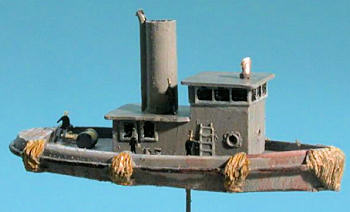 The mooring buoy was
made from
The mooring buoy was
made from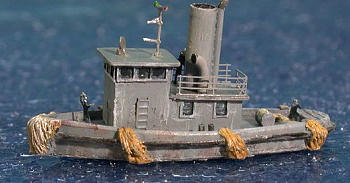 a section of styrene tubing, cut in half and closed at the ends with
sheet styrene. The mounting ring was made from thin wire and melted into the
plastic. The buoy was painted yellow and was weathered seriously.
a section of styrene tubing, cut in half and closed at the ends with
sheet styrene. The mounting ring was made from thin wire and melted into the
plastic. The buoy was painted yellow and was weathered seriously.
To make the scene a bit more lively, I decided to add two sailing boats. To this effect, two of the ship´s boats received a saling rig made from fine steel wire, cigarette paper and stretched sprue; the crew (as all the crew figures) is 1:700 Lion Roar PE figures. I have to thank Jim Baumann a lot for his hints on how sailing vessels should look and behave, how the crew would be placed and other issues improving realism; I used a number of images provided by Jim and some from the British National Maritime Museum´s website.
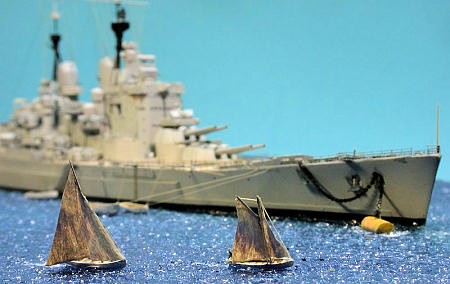 The base was made
from a picture frame. I removed the glass, placed the model on it, and marked
where my mounting holes would be. Then I carefully drilled holes through the
glass using a diamond bur in my Dremel. Now the ship could be secured to the
base using screws. That seemed to work fine yet later on – after completion -
led to a fine crack in the glass. These days, I would rather use a stainless
steel plate with screws or attach the model using acrylic gel.
The base was made
from a picture frame. I removed the glass, placed the model on it, and marked
where my mounting holes would be. Then I carefully drilled holes through the
glass using a diamond bur in my Dremel. Now the ship could be secured to the
base using screws. That seemed to work fine yet later on – after completion -
led to a fine crack in the glass. These days, I would rather use a stainless
steel plate with screws or attach the model using acrylic gel.
The wave patterns
were made by adding a coat of clear acrylic gel to the glass and spreading it
with a foam paint roller. The glass was then painted from below using cheap wall
paints from the hardware supermarket. These days I paint my (plaster) bases from
above and then add a number of coats of gloss lacquer – a much easier method and
an even nicer result!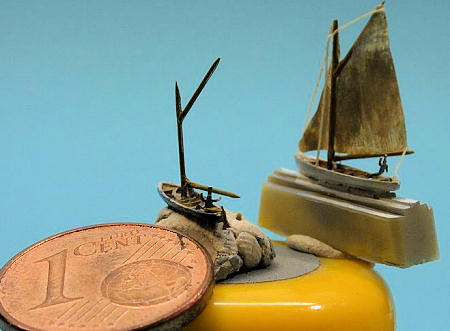
After screwing the model to the base, any remaining gaps were filled using acrylic gel. The boats and the tug were also glued to the base using acrylic gel. After curing, the boat booms were rigged using tan stretched sprue. The water spouts from the various outlets were made using stretched clear sprue glued with acrylic gel. The disturbed water below the outlets and around the boats was drybrushed using white artist´s oil paint.
The anchor chain from Saemann was weathered with a special burnishing chemical. The PE kit anchors were used and rigged after studying a lot of images of RN vessels moored to buoys. The kit contains only two accomodation ladders, without rails. So I had to cannibalize WEM´s 1:700 HMS Tiger and 1:600 HMS Ark Royal III set to make four complete sets – a fiddly task yet necessary for the diorama setting.
The images were taken indoors using my trusty Nikon Coolpix 995 on a tripod using manual white balance.
| REFERENCES |
 Raven / Roberts:
British Battleships of World War 2 (I used the much cheaper German version)
Raven / Roberts:
British Battleships of World War 2 (I used the much cheaper German version)
Wikipedia: http://en.wikipedia.org/wiki/HMS_Vanguard_%281944%29
A Vanguard veteran´s homepage: http://www.hms-vanguard.co.uk/
Images at Maritimequest with the image used for the diorama: http://www.maritimequest.com/warship_directory/great_britain/battleships/vanguard_1944/hms_vanguard_1944.htm
Acknowledgements:
A heartfelt thank you to Jim Baumann for his help and always constructive criticism, and for always giving me that special nudge I need to improve.
March 2008
Copyright ModelingMadness.com
If you would like your product reviewed fairly and fairly quickly, please contact the editor or see other details in the Note to Contributors.